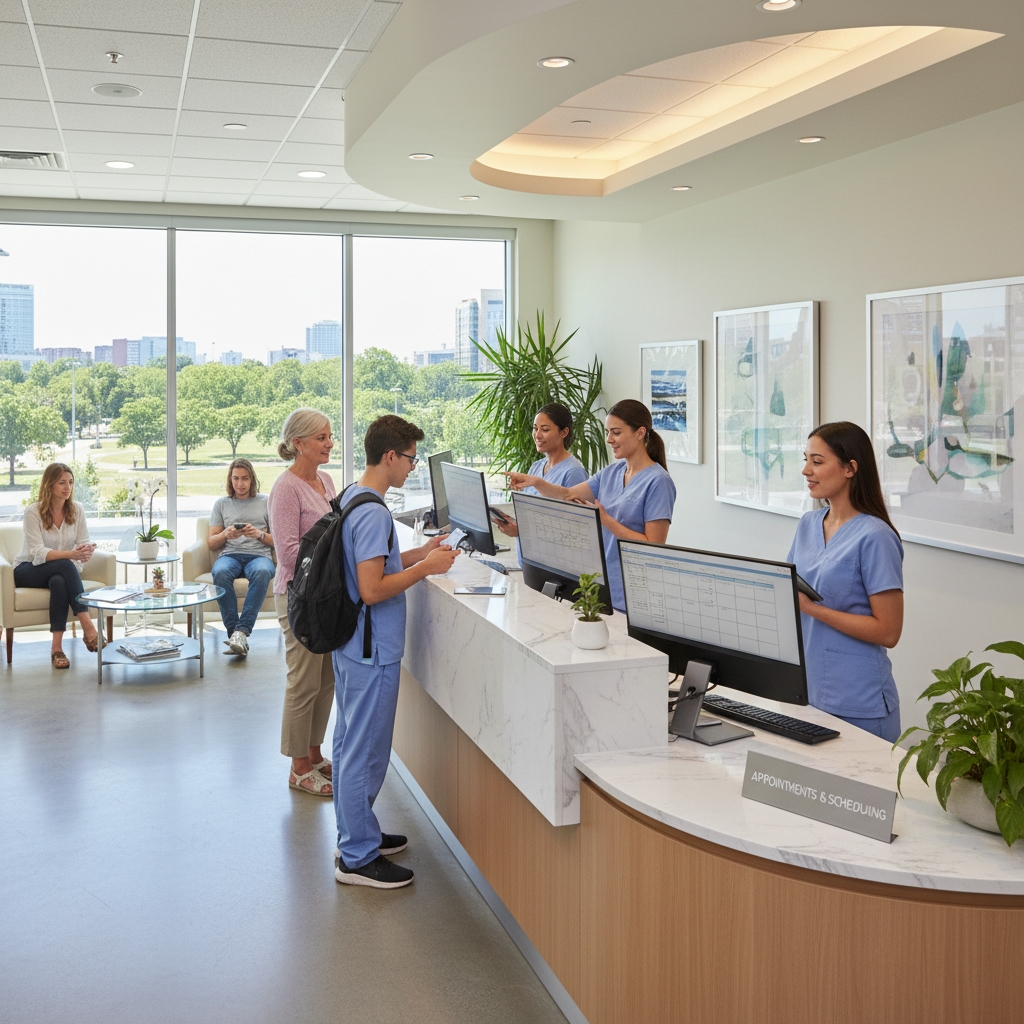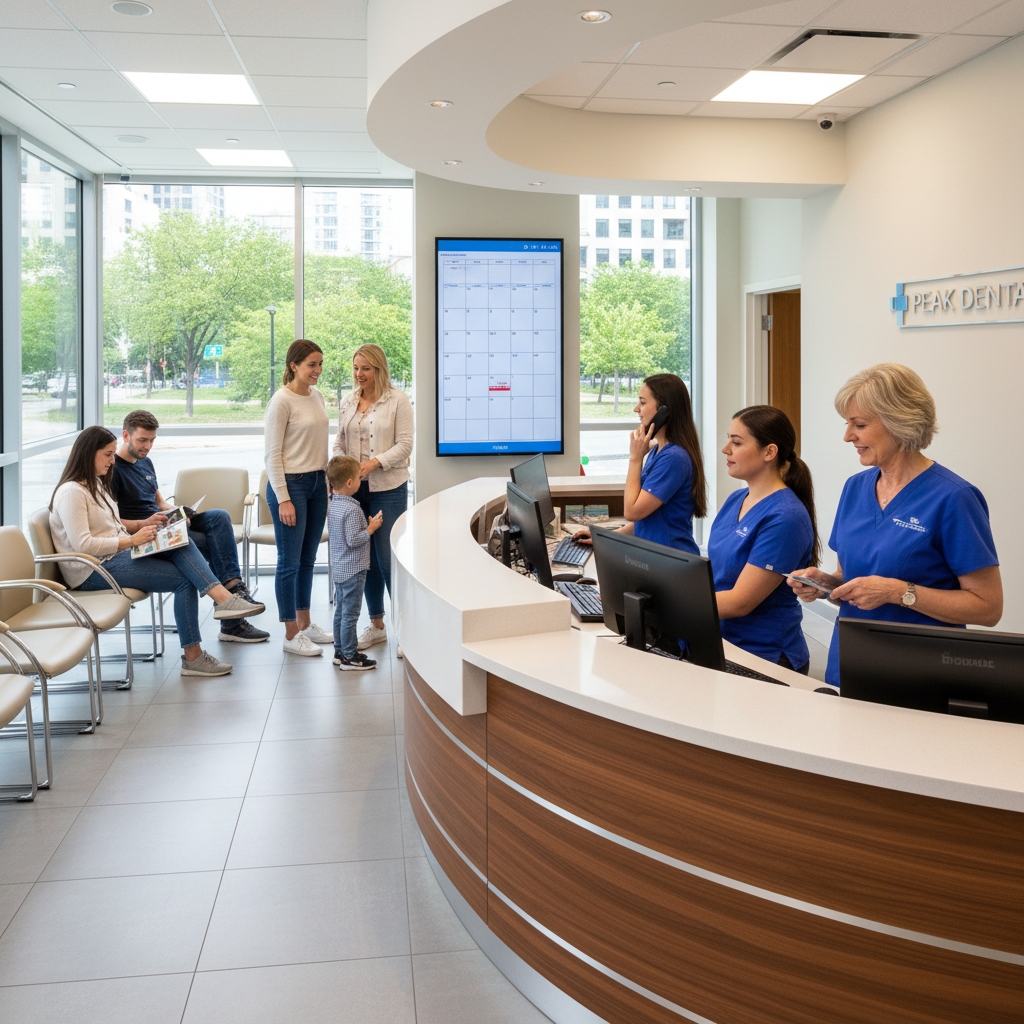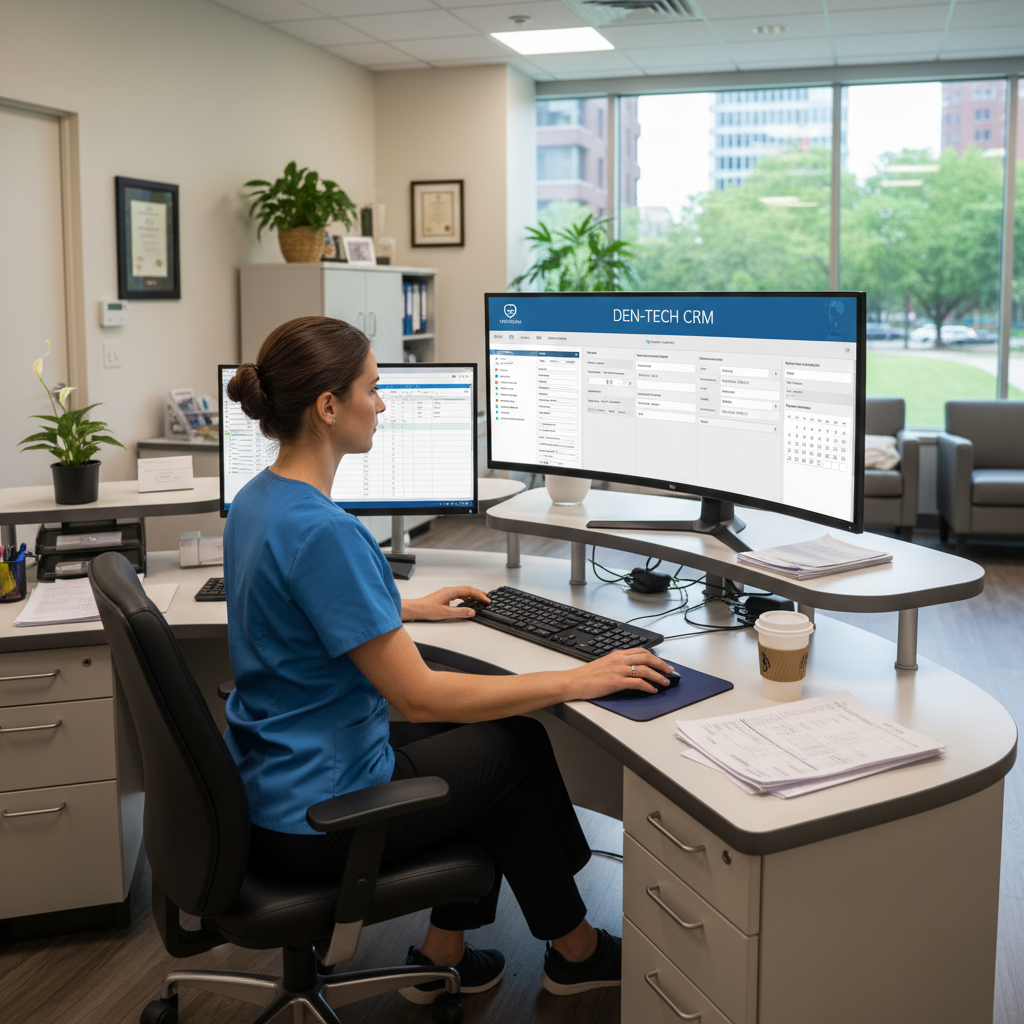












Blog Article


How to Prevent Patients from Calling Competitors Due to Missed Calls - Guide For Dentists and DSOs
Every missed call at a dental practice represents a potential patient walking through a competitor's door instead. Hospitals miss an average of 24% of inbound calls, creating significant revenue losses and sending patients directly to competing practices. When patients can't reach their preferred dental office, they don't wait around.
Implementing automated call capture systems and missed call text-back features can recover up to 60% of previously lost opportunities while preventing patient defection to competitors. Modern AI-powered systems automatically capture missed calls and convert them into scheduled appointments, ensuring no potential patient slips through the cracks.
The cost of losing patients to competitors extends beyond a single missed appointment. Each unanswered call potentially represents hundreds or thousands of dollars in lifetime treatment value, making call management a critical component of practice growth and patient retention strategies.
Key Takeaways
- Missed calls send patients directly to competing dental practices, creating immediate revenue loss and long-term patient defection
- Automated call capture and text-back systems can recover most missed opportunities while maintaining patient engagement
- Proper call flow optimization and appointment booking automation prevent competitors from gaining your potential patients
Missed Calls in Dental Practices
Dental practices lose approximately $100,000 annually when 30-35% of calls go unanswered. Only 42% of answered calls convert to appointments, creating compound revenue losses that affect practice growth and patient acquisition.
Missed Calls Impact Revenue
Each missed call represents immediate financial loss for dental practices. Studies show that 68% of calls remain unanswered, with only 42% of answered calls resulting in appointments.
This creates a devastating impact where practices lose 71 potential patients for every 100 calls received. The financial breakdown reveals significant revenue leakage:
- 32 unanswered calls per 100 received
- 39 answered calls that fail to convert
- Total missed opportunities: 71 patients
Revenue Loss Per 100 Calls:
- New patient examinations: $14,200-$28,400
- Treatment consultations: $35,500-$142,000
- Emergency appointments: $21,300-$56,800
Patient acquisition costs average $200-$300 per new patient through digital marketing. When calls go unanswered, practices waste marketing investments while losing potential lifetime patient value.
Emergency calls carry the highest immediate value. A single missed emergency appointment costs $500-$1,200 in same-day revenue, plus patients typically seek permanent care elsewhere.
Peak-Hour Missed Calls Statistics
Monday mornings and lunch hours generate the highest volume of missed calls in dental practices. Patients call to schedule appointments at the beginning of work weeks or during their lunch breaks.
High-Risk Time Periods:
- 8:00-10:00 AM on Mondays
- 12:00-1:00 PM daily
- 4:00-6:00 PM weekdays
- Weekend emergency calls
Front desk staff cannot effectively manage multiple responsibilities simultaneously. When employees handle check-ins, insurance verification, and payment processing, incoming calls frequently reach voicemail.
Small practices with 2-3 front desk staff face the greatest challenges. They cannot maintain phone coverage during lunch breaks, emergencies, or when staff assist patients in the office.
DSOs often struggle to maintain consistent phone standards across locations during peak times. Each location has different staffing levels and call volume patterns requiring customized coverage solutions.
Staff scheduling conflicts during peak periods lead to inadequate phone coverage. Proper staff training on call management becomes crucial for reducing missed appointment opportunities.
Patient Retention and Missed Calls
Patients experiencing dental pain or emergencies will quickly contact competing practices if their initial call goes unanswered. New patients who cannot reach a practice immediately are 73% more likely to book with competitors within the same day.
Patient expectations have changed dramatically in recent years. Patients expect immediate responses and convenient scheduling options similar to other service industries they interact with daily.
Key Patient Frustration Points:
- Busy signals during peak calling hours
- Lengthy hold times without call-back options
- Voicemail-only responses for urgent dental needs
- Delayed return calls extending scheduling timelines
Patients who experience difficulty scheduling initial appointments show 40% lower retention rates for preventive care visits. This reduces lifetime patient value significantly beyond the immediate missed appointment.
The customer experience deteriorates when patients cannot schedule appointments easily. This affects long-term retention rates and referral generation, multiplying the financial impact over time.
Quick response times demonstrate professionalism and care that patients associate with quality dental services. Practices with efficient call management systems retain more patients and generate higher satisfaction scores.
Why Patients Call Competitors
Dental practices lose patients to competitors primarily due to missed calls, poor availability, and significant revenue impacts from call abandonment. Understanding these patterns helps practices implement effective retention strategies.
Patient Frustration With Missed Calls
Patients experience immediate anxiety when dental offices don't answer their calls. 67% of patients call competitors when medical practices don't answer phones, with this percentage reaching 85% during urgent dental situations.
Dental emergencies create heightened stress levels. Patients with toothaches, broken crowns, or oral injuries need immediate reassurance and scheduling assistance.
Key frustration triggers include:
- Busy signals during business hours
- Voicemail systems with long wait times
- No callback within 2-4 hours
- Automated systems without human options
Trust erodes quickly when patients can't reach their dental practice. They interpret unanswered calls as poor organization or inadequate staffing levels.
Modern patients expect instant communication similar to other service industries. Call abandonment rates increase dramatically after 30 seconds of ringing without human contact.
Competitor Availability and Speed
Competing dental practices capture new patients through superior phone accessibility and immediate response times. Practices with excellent phone service maintain 92-97% annual patient retention rates.
Competitor advantages:
- Live answering within 2-3 rings
- Same-day emergency appointments
- Extended phone hours beyond standard business times
- Professional call handling protocols
Patients research alternative dentists within 30 minutes of experiencing poor phone service. Online directories and insurance networks make finding new providers extremely convenient.
Geographic proximity matters less when patients need urgent dental care. They frequently travel farther distances to reach practices known for excellent phone responsiveness and immediate appointment availability.
Social media and online reviews amplify competitor advantages. Practices emphasizing phone accessibility in marketing campaigns successfully capture market share from offices with missed calls that damage healthcare facility reputation.
Lost Production Metrics
Average revenue loss per missed call:
- New patient calls: $800-$1,200
- Emergency appointments: $300-$600
- Routine cleanings: $200-$400
- Cosmetic consultations: $2,000-$5,000
DSOs experience amplified losses across multiple locations. A single practice missing 10 calls weekly loses approximately $208,000-$312,000 annually in potential revenue.
Call abandonment creates cascading financial impacts. Lost patients represent lifetime values of $3,000-$8,000 per individual, including regular cleanings, restorative work, and family referrals.
Monthly tracking metrics:
- Total missed calls
- Peak abandonment hours
- Revenue per call type
- Patient acquisition costs vs. retention savings
Practices lose referral network stability when existing patients switch providers. Each departing patient typically influences 2-3 family members to seek alternative dental care, multiplying revenue losses significantly.
Call Answering Strategies for Dentists
Effective call management prevents patient loss to competitors and maximizes appointment bookings. Strategic availability, after-hours solutions, and overflow management create comprehensive communication systems that capture every potential patient interaction.
24/7 Availability for Dental Clinics
Dental practices lose significant revenue when patients cannot reach them during critical decision-making moments. Dental offices miss 38% of calls from potential patients, creating immediate opportunities for competitors.
Primary availability solutions include:
- Virtual receptionist systems that handle basic inquiries
- Automated scheduling platforms for appointment requests
- Emergency triage protocols for urgent dental needs
- Text messaging options for non-urgent communications
Practices must establish clear protocols for different call types. Emergency calls require immediate dentist contact, while routine inquiries can be managed through automated systems or scheduled callbacks.
Patient expectations have shifted toward instant communication. When dental offices provide 24/7 contact options, they capture patients who call outside traditional business hours. These extended availability windows often coincide with when patients research dental services online.
After Hours Call Solutions
Modern dental practices need systematic approaches to handle calls when staff is unavailable. Handling after-hours calls effectively using automated systems prevents patient loss without requiring overnight staffing.
Effective after-hours strategies:
Solution Type Best For Implementation Cost
Call forwarding Emergency situations Low
Automated systems Appointment scheduling Medium
Virtual receptionists Full-service handling High
Targeted interventions for after-hours calls should distinguish between emergencies and routine requests. Emergency protocols must connect patients directly with on-call dentists or emergency services.
Text messaging integration allows patients to leave detailed messages about their needs. This creates a paper trail for follow-up and helps staff prioritize callbacks the next business day.
Reducing Overflow Call Losses
Peak call times create bottlenecks that drive patients to competitors. Dental practices experience highest call volumes Monday mornings and after holiday weekends, requiring specific overflow management strategies.
Overflow reduction tactics:
- Multiple phone lines with automatic routing
- Queue management systems with callback options
- Staff scheduling aligned with call volume patterns
- Phone answering strategies for dental practices that convert more patients
Call management systems should track peak times and missed call patterns. This data reveals when additional staff coverage is needed and which services generate the most inquiries.
Practices can implement callback systems where patients leave their information rather than waiting on hold. This prevents abandonment while ensuring every caller receives attention within predetermined timeframes.
Appointment Booking Automation
Dental practices lose patients to competitors when calls go unanswered during busy periods or after hours. Automated appointment booking systems eliminate this problem by allowing patients to schedule visits 24/7 through multiple channels.
Automated Scheduling for Dentists
Modern dental practices need systems that work around the clock. Online booking platforms let patients schedule appointments through websites, mobile apps, or chatbots without calling the office.
These systems sync with practice management software in real time. When a patient books online, the appointment automatically appears in the dental office schedule. Staff receive instant notifications about new bookings.
Key features include:
- 24/7 availability for patient bookings
- Real-time calendar integration
- Multiple booking channels (web, mobile, text)
- Staff notification systems
Automated scheduling reduces phone volume during peak hours. Patients get immediate confirmation instead of waiting for callbacks. This prevents them from calling competitors when the main line is busy.
The system also handles cancellations and rescheduling automatically. Patients can modify their appointments without staff involvement, freeing up team members for other tasks.
Reducing No-Shows With Quick Booking
Fast booking processes keep patients engaged and committed to their appointments. When patients can schedule immediately, they're more likely to follow through with their visit.
Automated reminder systems significantly reduce no-show rates, with some practices seeing drops from 15% to 9%. These systems send multiple touchpoints through different channels.
Effective reminder strategies include:
- Text messages 48 hours before appointments
- Phone calls 24 hours in advance
- Email confirmations with calendar links
- Same-day appointment alerts
Quick booking also captures patients during decision-making moments. When someone searches for dental services, they can book immediately rather than planning to call later. This eliminates the risk of patients forgetting or choosing competitors.
Confirmation requests through automated systems improve patient communication. Patients can confirm, reschedule, or cancel with simple responses, giving practices time to fill open slots.
Patient Experience and Automated Bookings
Automated booking systems improve patient satisfaction by offering convenience and flexibility. Patients appreciate being able to schedule appointments during their lunch breaks or after work hours.
The booking process should be simple and fast. Patients enter basic information, select available times, and receive instant confirmation. Complex forms or multiple steps discourage completion.
Best practices for patient experience:
- Mobile-friendly booking interfaces
- Clear availability displays
- Instant confirmation messages
- Easy rescheduling options
Patient engagement increases when booking is convenient. Younger patients especially prefer digital booking options over phone calls. Offering both options ensures all patient preferences are met.
Automated systems also collect patient information beforehand. New patients can complete forms online before their visit, reducing wait times and improving office efficiency. This creates a smoother experience that encourages patient loyalty.
Analytics for Dental Practice Calls
Call analytics means collecting and studying data about phone calls to identify patterns in patient behavior and practice performance. These insights help practices understand when most calls are missed, which follow-up methods work best, and how much revenue gets recovered from previously lost opportunities.
Missed-Call Heatmap Insights
Dental practices need to identify peak missed-call periods to optimize staffing and resource allocation. Monday mornings between 8:00-10:00 AM and lunch hours from 12:00-1:00 PM typically show the highest miss rates across practices.
Heatmap data reveals specific patterns that impact operational efficiency. Emergency calls spike during evenings and weekends when regular staff coverage ends. Routine appointment requests concentrate during weekday business hours when patients call from work.
Critical time periods requiring attention:
- Monday morning appointment requests (highest volume)
- Lunch break coverage gaps (12:00-1:30 PM)
- After-hours emergency calls (4:00-6:00 PM)
- Weekend urgent care inquiries
DSOs managing multiple locations benefit from comparing heatmaps across sites. Some locations may show different peak periods based on local demographics or nearby business districts. This data helps allocate staff resources more effectively during high-risk periods.
Practices can use this information to adjust staffing schedules. Adding dedicated phone coverage during peak periods reduces missed opportunities and improves patient satisfaction rates.
Revenue Attribution With Analytics
Revenue tracking connects missed calls to actual dollar amounts lost and recovered. Each missed call represents potential treatment value ranging from $200-$400 for routine cleanings to $2,000+ for complex procedures.
Analytics platforms calculate monthly revenue impact by multiplying missed calls by average treatment values. A practice missing 32 calls monthly could lose $6,400-$64,000 depending on procedure mix and patient demographics.
Revenue calculation components:
- Total missed calls per month
- Average treatment value by call type
- Conversion rate from callbacks to appointments
- Lifetime patient value for new acquisitions
Recovery metrics show which follow-up methods generate the most revenue. AI-powered systems can automatically capture these missed calls and convert them into scheduled appointments, helping practices recover up to 60% of previously lost opportunities.
DSOs need location-specific revenue attribution to identify underperforming sites. Practices with lower conversion rates may need additional staff training or system improvements to match top-performing locations.
Staff Follow-Up Tracking Metrics
Staff performance metrics measure how effectively teams convert missed calls into appointments. Response time, callback success rates, and appointment booking percentages provide clear performance indicators.
Key follow-up metrics include:
- Average response time to missed calls
- Number of callback attempts before connection
- Conversion rate from callbacks to scheduled appointments
- Staff member performance comparisons
Manual follow-up processes often show response times exceeding 4-6 hours, while automated systems respond within 60 seconds. This speed difference directly impacts conversion rates and patient satisfaction.
Staff training improvements become evident through tracking metrics over time. Teams that receive proper phone handling training show 15-25% higher conversion rates compared to untrained staff members.
DSOs use these metrics to standardize training across locations. Top-performing staff members can mentor underperforming colleagues using specific data points rather than general feedback. This approach creates measurable improvements in call handling effectiveness.
Multi-Location and Custom Integrations
Dental practices expanding across multiple locations need centralized call management systems to prevent patient loss to competitors. Custom integrations with practice management software and white-label solutions help DSOs maintain brand consistency while ensuring no calls go unanswered.
Multi-Location Roll-Out Best Practices
DSOs managing multiple dental practices face unique challenges when implementing call handling systems. Call center systems for multi-location medical practices help reduce communication silos between offices.
Centralized call routing ensures patients reach the right location immediately. Set up overflow protocols so busy offices can transfer calls to less busy locations within the same network.
Staff training must be standardized across all locations. Create unified scripts and protocols that maintain your brand voice regardless of which office answers.
HIPAA compliance becomes more complex with multiple locations. Each office needs consistent data handling procedures and secure communication channels.
Roll out new systems gradually rather than all at once. Start with pilot locations to identify potential issues before full deployment. This approach reduces disruptions and allows for system refinements.
Monitor call metrics across all locations using centralized dashboards. Track missed calls, response times, and patient satisfaction scores to identify underperforming offices.
Custom Integrations for Dental PMS
Modern dental practices require seamless integration between call handling systems and practice management software. Custom API connections eliminate double data entry and reduce scheduling errors.
Real-time appointment scheduling through integrated systems prevents double bookings. When patients call any location, staff can view availability across the entire network instantly.
Patient records sync automatically between call systems and PMS platforms. This integration allows staff to access treatment history, insurance information, and scheduling preferences during phone calls.
Automated appointment confirmations reduce no-shows significantly. Integrated systems can send personalized reminders via text, email, or phone calls based on patient preferences stored in the PMS.
Payment processing integration allows staff to handle billing inquiries and collect payments during phone calls. This reduces administrative overhead and improves patient satisfaction.
Custom integrations also enable automated appointment scheduling tools that sync across multiple clinic locations in real-time.
White-Label Solutions for DSOs
Large dental organizations need call handling solutions that reflect their brand identity across all touchpoints. White-label platforms allow complete customization of patient-facing communications.
Custom branding extends to hold music, greeting messages, and automated responses. Patients hear consistent messaging whether calling the main office or satellite locations.
Branded mobile apps and patient portals integrate with white-label call systems. This creates a unified experience from initial contact through treatment completion.
Multi-tenant architecture allows DSOs to manage different practice brands under one system. Each location maintains its unique identity while benefiting from centralized management.
Training materials and staff interfaces can be customized with DSO branding and protocols. This reinforces company culture and ensures consistent service delivery.
White-label solutions also provide detailed analytics dashboards branded for the DSO. Management can monitor performance metrics across all locations using familiar branding and terminology.
Custom reporting features allow DSOs to track KPIs specific to their business model and growth objectives.
Resonate for Preventing Missed Calls
Resonate offers dental practices an AI-powered solution that automatically handles missed calls through intelligent voice assistants and scheduling automation. The platform provides real-time analytics to track patient interactions and optimize appointment conversion rates.
AI Receptionist for Dental Practices
Resonate's AI voice assistant operates 24/7 to ensure dental practices never lose potential patients to unanswered calls. The system automatically picks up missed calls and engages patients using natural conversation patterns that mirror human receptionists.
The AI receptionist understands dental-specific terminology and procedures. It can handle appointment requests for cleanings, emergency visits, consultations, and specialized treatments. Patients receive immediate responses instead of waiting for callback attempts that may never come.
Key capabilities include:
- Emergency call prioritization and routing
- Insurance verification assistance
- Appointment availability checking
- Basic procedure information delivery
The technology integrates directly with existing dental practice management systems. This connection allows the AI voice assistant to access real-time scheduling data and book appointments instantly. Patient satisfaction increases when calls receive immediate attention, especially during peak hours when front desk staff cannot answer phones.
Studies show that dental practices miss 32% of incoming calls from new patients, making automated solutions essential for revenue protection.
Context-Aware Chat for Scheduling
The platform's chat system understands the context of patient inquiries and responds appropriately based on urgency and treatment type. Emergency dental situations receive different handling protocols than routine cleaning appointments.
Context-aware technology analyzes patient language patterns to determine appointment urgency. Pain-related keywords trigger immediate escalation protocols. Routine inquiries follow standard scheduling workflows with available time slot presentations.
Chat features include:
Feature Benefit
Urgency detection Prioritizes emergency cases
Insurance integration Verifies coverage instantly
Multi-language support Serves diverse patient populations
Appointment confirmations Reduces no-show rates
The system sends scheduling links via text message for convenient booking. Patients can select preferred appointment times without additional phone calls. This streamlined process improves customer experience while reducing administrative workload for dental staff.
Follow-up messages confirm appointments and send reminders. The automated sequence continues until patients either book appointments or explicitly decline services.
Analytics Dashboard for Practices
Resonate provides comprehensive analytics that track missed call patterns and conversion rates across different time periods. Dental practices can identify peak missed call times and adjust staffing accordingly.
The dashboard displays real-time metrics on call volume, response rates, and appointment bookings generated through AI interactions. Practice managers can monitor which types of inquiries convert best and optimize messaging strategies.
Dashboard metrics include:
- Call volume trends by day and hour
- Conversion rates from calls to appointments
- Response time averages for different inquiry types
- Revenue attribution from recovered missed calls
DSOs benefit from multi-location reporting that compares performance across different practice sites. The analytics help identify top-performing locations and replicate successful strategies organization-wide.
Monthly reports show up to 60% conversion rates for previously missed opportunities. These insights enable data-driven decisions about staffing, marketing, and patient communication strategies. Customer satisfaction scores improve when practices can demonstrate consistent response times and appointment availability.
Frequently Asked Questions
Dental practices face unique challenges when managing patient calls, with 67% of patients calling competitors when their primary provider doesn't answer. Understanding proper call management strategies, staff training protocols, and technology solutions helps dental offices maintain patient loyalty and prevent revenue loss from missed appointment opportunities.
What strategies can dental practices implement to manage missed calls effectively?
Dental practices should establish a standardized call handling protocol that ensures every call receives attention within three rings or gets redirected to voicemail with clear response timeframes. Staff members need designated backup coverage during peak hours, lunch breaks, and patient care periods.
Implementing a call queue system allows practices to manage multiple incoming calls simultaneously. This prevents patients from hearing busy signals that often trigger immediate competitor searches.
Practices should track missed call patterns to identify peak demand periods. Many dental offices experience call surges on Monday mornings and after holiday weekends when patients schedule routine cleanings and address urgent issues.
Creating a dedicated phone line for emergency calls ensures urgent dental situations receive immediate attention. This separation prevents routine appointment requests from blocking emergency access.
How can dentists ensure patient retention even when calls are missed?
Prompt callback protocols within 15-30 minutes demonstrate practice responsiveness and prevent patients from seeking alternative providers. Staff should document the reason for each missed call and prioritize callbacks based on urgency levels.
Dentists can implement proactive communication by sending appointment reminders via text and email. This reduces the volume of confirmation calls that tie up phone lines during busy periods.
Offering multiple contact methods including online scheduling portals gives patients alternatives when phone lines are busy. Many patients prefer digital booking options for routine cleanings and check-ups.
Following up on missed calls with personalized messages shows patients their needs matter. Simple acknowledgments of communication delays often restore patient confidence in the practice.
What technology solutions are available to reduce the incidence of missed calls in dental offices?
Automated phone systems with intelligent routing direct calls to appropriate staff members based on patient needs. Emergency calls can route directly to clinical staff while billing questions go to administrative personnel.
Call forwarding systems ensure coverage during staff breaks, meetings, and after-hours periods. Calls can redirect to answering services or designated staff mobile phones to maintain accessibility.
Voice-over-Internet-Protocol (VoIP) systems provide advanced features like call recording, analytics, and integration with practice management software. These tools help practices monitor call handling performance and identify improvement areas.
Online scheduling platforms integrated with practice management systems allow 24/7 appointment booking without phone interaction. Patients can view real-time availability and select convenient appointment slots.
What best practices should dental office staff follow to minimize the risk of patients turning to competitors after missed calls?
Staff should answer phones with consistent professional greetings that include practice name and staff member identification. This creates positive first impressions that reinforce practice branding.
Training staff to handle multiple call types efficiently prevents long hold times that frustrate callers. Administrative staff should know when to transfer calls to clinical personnel for treatment questions.
Establishing clear escalation procedures ensures complex situations receive appropriate attention quickly. Staff need guidelines for identifying urgent dental situations that require immediate clinical consultation.
Documentation of all patient interactions helps staff provide consistent service across multiple touchpoints. Notes about previous conversations prevent patients from repeating information unnecessarily.
How important is it to train dental staff in call management to prevent losing patients to competing practices?
Staff training directly impacts patient retention rates and practice revenue. Untrained staff often handle calls inefficiently, creating negative experiences that drive patients to seek alternative dental providers.
Proper training reduces call handling time while improving patient satisfaction scores. Staff learn to gather necessary information quickly and route calls to appropriate personnel without delays.
Regular training updates ensure staff stay current with practice protocols and technology systems. New software features and procedure changes require ongoing education to maintain service quality.
Role-playing exercises help staff practice difficult scenarios before encountering real patient situations. This preparation builds confidence and improves response quality during stressful interactions.
What role does patient communication play in preventing missed opportunities due to unanswered calls?
Clear communication about practice hours, emergency procedures, and contact methods sets appropriate patient expectations. Well-informed patients understand when and how to reach the practice effectively.
Proactive communication through newsletters, social media, and patient portals reduces reactive phone calls. Patients who receive regular updates about services and procedures need less phone-based information.
Transparent scheduling policies help patients understand appointment availability and cancellation procedures. This clarity reduces confusion-related calls that tie up phone lines unnecessarily.
Educational content about common dental procedures and post-treatment care reduces anxiety-driven calls. Patients with access to reliable information feel more confident managing minor concerns independently.
Similar Articles
Ready to Get Started
Have Questions?
We're Here to Help
Connect with our team for personalized guidance
No setup fees, cancel anytime.
.avif)


.svg)
.svg)





